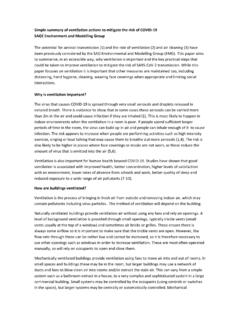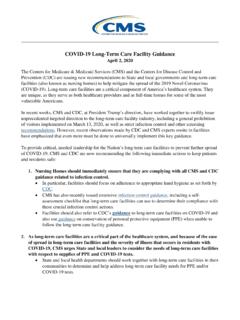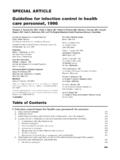Transcription of Fire and Rescue National Framework for England
1 fire and Rescue National Framework for England May 2018 fire and Rescue National Framework for England 1 CONTENTS Foreword 3 1. INTRODUCTION 5 Powers 5 Priorities 5 2. DELIVERY OF FUNCTIONS 6 Identify and Assess 6 Prevent and Protect 6 Respond 7 Collaboration 7 3. National RESILIENCE 9 Gap Analysis 9 National Coordination and Advisory Framework 10 Response to Terrorist Attacks or Marauding Terrorist Firearms Attacks 10 National Resilience Assurance 10 4. GOVERNANCE 11 Managing the fire and Rescue Service/Chief fire Officer 11 Documents to be Prepared 12 National fire Chiefs Council 13 5. ACHIEVING VALUE FOR MONEY 14 Reserves 14 Commercial Transformation 15 Research and Development 16 Trading 16 6. WORKFORCE 17 People Strategy 17 Professional Standards 17 Fitness Principles 17 Re-engagement of Senior Officers 18 7. INSPECTION, INTERVENTION AND ACCOUNTABILITY 19 fire and Rescue National Framework for England 2 Inspection 19 Intervention 19 Accountability 20 Transparency 21 8.
2 TIMESCALE AND SCOPE 22 Timescales 22 Scope 22 Annex A - Requirements on fire and Rescue Authorities in England 23 Annex B - Published Financial Guidance (see Chapter 5) 24 Annex C - Fitness Principles 25 Annex D - Protocol on Central Government Intervention Action for fire and Rescue Authorities 26 fire and Rescue National Framework for England 3 Foreword fire and Rescue services play a crucial role in making our communities safer, whether it be preventing and protecting people from fire and other risks, or responding swiftly and effectively to the incidents and emergencies that occur. Over the past decade we have witnessed a significant decrease almost half - in the number of fires attended which suggests that we are, as a society, becoming safer than ever from the risks and consequences of fire . This decrease can be attributed to many factors, including in part testament to the successful fire prevention and protection work that fire and Rescue services deliver day in, day out, up and down the country.
3 We must continue to work hard to keep people especially those whose vulnerability to fire is increased by age, infirmity, mental health, domestic violence or any of the other complex issues some of us are living with as safe from fire risks as possible. In many cases, this means engaging effectively with other agencies to work together to better protect and improve the outcomes for these individuals. Nevertheless, the awful tragedy at Grenfell Tower provided a stark and terrible reminder that we can never afford to become complacent. The past decade has also seen fire and Rescue services respond to an ever growing number of non- fire incidents. I expect collaboration to be at the heart of how services operate so that services can work with, or on behalf of, local providers, to deliver a range of public safety activity to protect their local communities, where it is in the interests of efficiency and effectiveness for them to do so.
4 But such activity must not be at the expense of services core functions around prevention, protection and response as that is ultimately what the taxpayer funds fire and Rescue services to deliver. In 2016, the Home Office outlined an ambitious programme of reform which it is delivering with the fire and Rescue sector. We want to support the continuous improvement of fire and Rescue services, enabling them to be more accountable, effective and professional than ever before, building on the great strides in prevention and collaboration that they have already made. This revised National Framework seeks to embed these reforms, which include: transforming local governance of fire and Rescue by enabling mayors and police and crime commissioners to take on responsibility for their fire and Rescue service where a local case is made; establishing Her Majesty s Inspectorate of Constabulary and fire and Rescue Services (HMICFRS) as an independent inspection regime for fire and Rescue services; developing a comprehensive set of professional standards to drive sector improvement; supporting services to transform commercially with more efficient procurement and collaboration; increasing the transparency of services with the publication of greater performance data and the creation of a new National fire website.
5 And driving forward an ambitious programme for workforce reform including through enhancing: professionalism; management and leadership; training and development; equality and diversity; culture; and options for flexible working. fire and Rescue National Framework for England 4 It is against this background that the Government issues this revised National Framework . I am grateful to all those who responded to our consultation. We have carefully considered every response and amended the National Framework as appropriate. Our consultation response has been published separately. The National Framework will continue to provide an overall strategic direction to fire and Rescue authorities, but Whitehall will not run fire , and fire and Rescue authorities and their services remain free to operate in a way that enables the most efficient and effective delivery of their services, drawing upon their considerable skills and experience to best reduce the risks from fire .
6 Ultimately, it is to local communities, not Government, that fire and Rescue authorities are accountable. The fire landscape is changing with different governance models, the new inspectorate and the recently created National fire Chiefs Council. This revised Framework outlines the new roles and responsibilities of these changes and sets expectations for how services should work with the new arrangements. Finally, it is vital that we learn the lessons from Grenfell. I very much welcome the publication of Dame Judith Hackitt s interim report setting out a comprehensive analysis of the current system of building regulations and fire safety and providing recommendations for how it can be improved. We agree with her call for a change in culture and a more effective system that will encourage people to do the right thing and hold to account those who try to cut corners.
7 The scale of the change indicated in her Interim Report cannot be delivered by government alone. We will work closely with Dame Judith and other partners including the National fire Chiefs Council and fire and Rescue services to implement her short-term recommendations and to identify the long-term changes that will need to be made to the system over time. We will update the National Framework as required to ensure that the learning and recommendations from this Review, as well as those from the wider Grenfell Tower Inquiry, are captured and reflected. In the meantime, we acknowledge the vital work that local fire and Rescue services, and the National fire Chiefs Council - as a member of the Expert Panel - are doing to ensure that building owners are taking all the necessary steps to ensure those living in high rise buildings are safe and feel safe to remain in their homes.
8 I look forward to continuing to see the important and life-saving work that fire and Rescue services deliver. Rt Hon Nick Hurd MP Minister of State for Policing and the fire Service fire and Rescue National Framework for England 5 1. INTRODUCTION Powers Under section 21 of the fire and Rescue Services Act 2004 ( the 2004 Act ), the Secretary of State must prepare a fire and Rescue National Framework . The Framework : a) must set out priorities and objectives for fire and Rescue authorities in connection with the discharge of their functions; b) may contain guidance to fire and Rescue authorities in connection with the discharge of any of their functions; and c) may contain any other matter relating to fire and Rescue authorities or their functions that the Secretary of State considers appropriate. In setting out priorities and objectives for fire and Rescue authorities in England , the requirements are best calculated to promote public safety and the economy, efficiency and effectiveness of fire and Rescue authorities.
9 The Framework sets out high level expectations; it does not prescribe operational matters which are best determined locally by fire and Rescue authorities and their staff. In preparing the Framework , the Secretary of State undertook a public consultation which met the requirements of the 2004 Act, namely to include fire and Rescue authorities or their representatives; persons representing employees of fire and Rescue authorities; and any other persons considered appropriate as required by the 2004 Act. Every fire and Rescue authority must have regard to the Framework in carrying out their functions. Every authority must publish an annual statement of assurance of compliance with the Framework (see Chapter 4). fire and Rescue authorities function within a long-established statutory and policy Framework . This document does not repeat all the duties placed on them in connection with the discharge of their functions, or more generally as a public service provider and employer.
10 The term fire and Rescue authority in this Framework applies to every fire and Rescue authority in England unless otherwise stated. Priorities The priorities in this Framework are for fire and Rescue authorities to: make appropriate provision for fire prevention and protection activities and response to fire and Rescue related incidents; identify and assess the full range of foreseeable fire and Rescue related risks their areas face; collaborate with emergency services and other local and National partners to increase the efficiency and effectiveness of the service they provide; be accountable to communities for the service they provide; and develop and maintain a workforce that is professional, resilient, skilled, flexible and diverse. fire and Rescue National Framework for England 6 2. DELIVERY OF FUNCTIONS Identify and Assess Every fire and Rescue authority must assess all foreseeable fire and Rescue related risks that could affect their communities, whether they are local, cross-border, multi-authority and/or National in nature from fires to terrorist attacks.

















